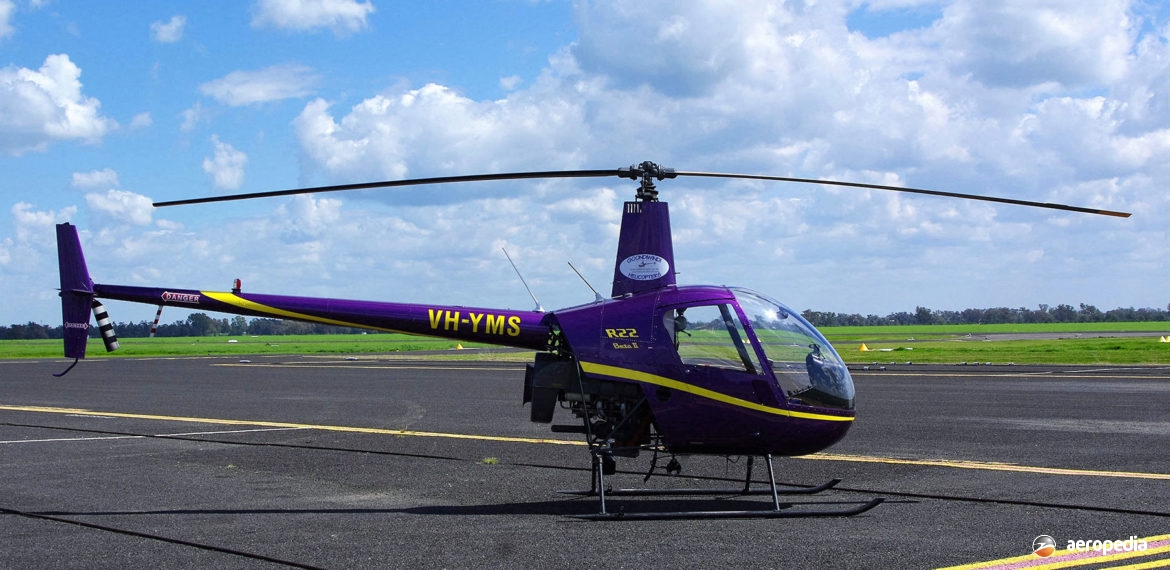Photograph:
Robinson R-22 VH-YMS (c/n 4455) at Goondiwindi, QLD in August 2010 (David C Eyre)
Country of origin:
United States of America
Description:
Light general purpose helicopter
Power Plant:
One 112 kw (150 hp) Lycoming O-320-A2B four-cylinder horizontally-opposed air-cooled engine de-rated to 92 kw (124 hp)
Specifications:
- Rotor diameter: 7.67 m (25 ft 2 in)
- Overall length: 8.76 m (28 ft 9 in)
- Height: 2.67 m (8 ft 9 in)
- Max speed: 190 km/h (119 mph)
- Cruising speed at 75% power: 174 km/h (108 mph)
- Initial rate of climb: 366 m/min (1,200 ft/min)
- Service ceiling: 4,265 m (14,000 ft)
- Hovering ceiling in ground effect: 1,981 m (6,500 ft)
- Max range with no reserves: 386 km (240 miles)
- Empty weight: 361 kg (796 lb)
- Loaded weight: 590 kg (1,300 lb)
History:
The R-22 light helicopter was designed by Frank D Robinson. The first of two prototypes, which was flown on 28 August 1975, was the result of six years of development work. The second prototype, which was flown for the first time in 1977, was used for certification flying, this being received in March 1979, having been delayed somewhat by the loss of the prototype in an accident.
Following the cessation of the production of the Bell 47 series, the R-22 became the only two-seat, light helicopter in production for a period and, as such, attracted widespread interest from around the world, orders having been received for more than 600 aircraft by late 1979. The type has been produced in a facility at Torrance Airport, Los Angeles. The fuselage is built as a pod, with two seats side-by-side, and a tubular boom carrying the tail rotor. Both the main and tail rotors are two-bladed; the main is of bonded construction with a stainless-steel leading edge for corrosion resistance. A single cyclic control stick is fitted in the centre of the cabin, and either pilot could fly the machine using the same controls.
The R-22 was designed to provide a cheap, light, simple helicopter, but with good reliability and performance. The prototype was fitted with an 86 kw (115 hp) Lycoming O-235 engine, but production machines were fitted with the 112 kw (150 hp) Lycoming O-320, this being de-rated to 92.5 kw (124 hp), thus allowing the power to be constant up to a height of 2,525 m (5,000 ft).
The type has proved very popular with air-training organisations throughout the world. Since the type’s introduction to Australia in the early 1980s, many have been used for rotary-wing training, and quite a number have been used in the cattle-mustering industry, radio station traffic reporting etc.
Late in 1981 the Robinson Helicopter Co introduced a new model to the series, known as the high-performance R-22HP. Powered by a 119 kw (160 hp) Lycoming O-320-B2C engine de-rated to 92.5 kw (124 hp), this variant cruised at 177 km/h (110 mph) at 75% power, had a service ceiling of 4,267 m (14,000 ft), and hovering ceilings in and out of ground effect of 2,530 m (8,300 ft) and 1,950 m (6,400 ft) respectively.
The R-22 has been a very popular light helicopter since its introduction, and development has led to a number of further models. In 1983 the R-22 Alpha was introduced, followed by the R-22 Beta in 1985, the R-22 Mariner which had floats, and the R-22 Police, which had special communications gear, a searchlight, siren and a loudspeaker. The R-22 agricultural was fitted with tanks and booms for spraying work, and the R-22 IFR was for instrument helicopter training. In more recent times production aircraft have been fitted with the 119 kw (160 hp) [de-rated to 98 kw/131 hp] Textron Lycoming O-360 engine, this providing a better performance, especially in hot and high conditions. The R-22 Beta II was introduced in 1985.
Well over 600 examples have appeared on the Australian register, and some 355 are registered at present. More than 150 appear on the New Zealand register. A system was developed in Australia for spraying with the R-22, this having a capacity of 90 litres (19.8 Imp gals) with a boom width of 10 m (27 ft) and a swathe width of 20 m (54 ft). In the United States, Classic Helicopters obtained approval for a sling hook for the type, aimed at training pilots to carry externally slung loads, the hook being limited to 181 kg (400 lb) and a max speed of 139 km/h (86 mph).
The type has become increasingly popular for fish reconnaissance from tuna fishing boats. It has also been used by a number of the world’s air forces for training. In the United States an R-22 (N90718) set three world speed records for helicopters in its class. Wayne Mulgrew of Yreka, California removed the undercarriage to minimise drag and, carrying minimum fuel, achieved 230.79 km/h (143.41 mph) over three kilometres; broke the 15 km (9.32 miles) record with a speed of 213.56 km/h (132.71 mph); and for the 100 km (62.13 miles) closed circuit set a record of 204.49 km/h (127.07 mph). In the mid-1990s the R-22 was the world’s best-selling helicopter.

